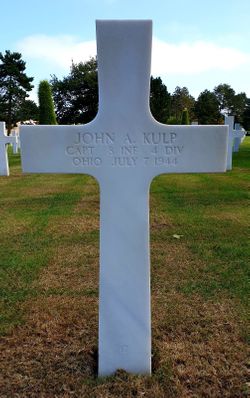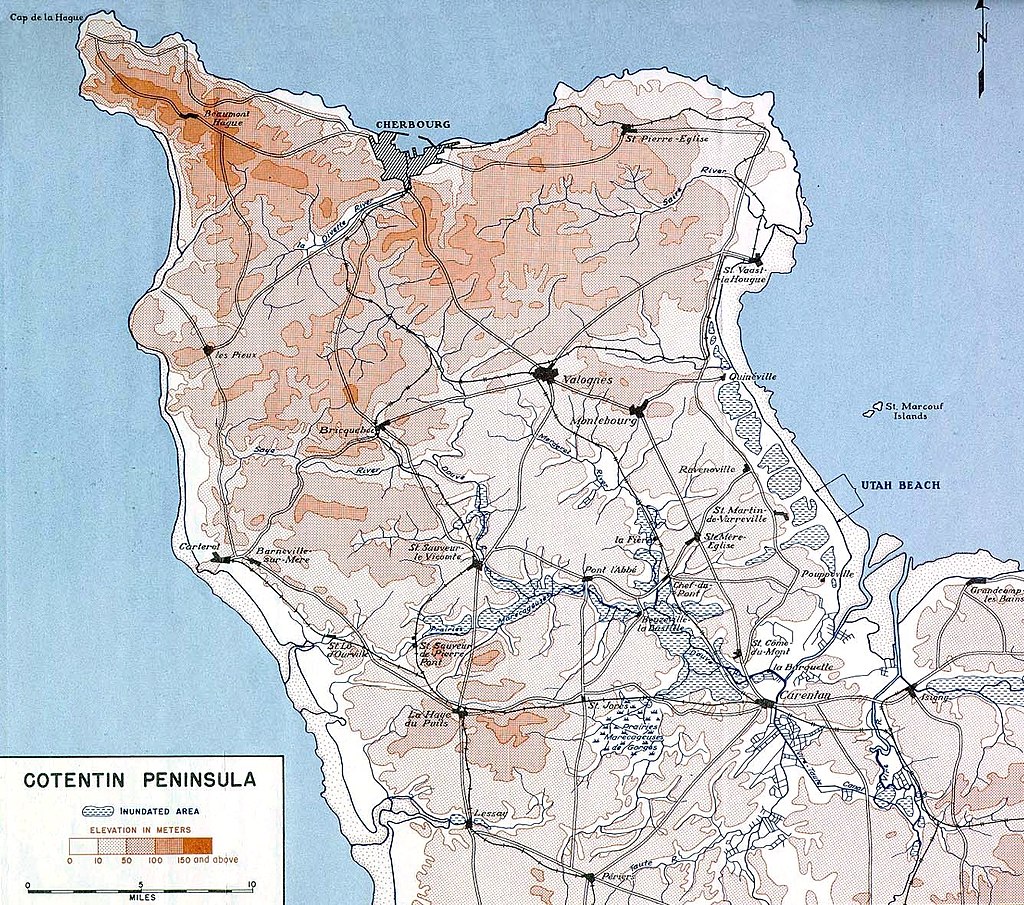Captain John A. Kulp

- Unit: 4th Infantry Division, 8th Infantry Regiment, Company F
- Service Number: O-1285773
- Date of Birth: November 30, 1916
- Entered the Military: October 15, 1940
- Date of Death: July 7, 1944
- Hometown: Columbus, Ohio
- Place of Death: near Cherbourg, France
- Award(s): Purple Heart, Distinguished Service Cross
- Cemetery: Plot C, Row 20, Grave 17. Normandy American Cemetery, Colleville-sur-Mer, France
Mentored by Mr. Joseph Boyle
Rogers High School
2010-2011
Early Life
Establishing the Family Business
The Kulp family emigrated from Germany to the United States in the early 1800s. In May 1845, John Kulp became the first member of the family born in the United States. In 1865, he married a woman named Mary and they had several children: Florence, Nettie, Harry, Frank, and John.
John Kulp, Sr. worked as a brick manufacturer and all of the boys, except John, entered the family business. John remained in school.
By the mid 1910s, Frank Kulp took over as the owner of the family brickyard and married a woman named Ella. They had several children. The youngest child was John A. Kulp, known affectionately by the nickname Jack. John lived with his siblings, Florence, Betty, and Frank. Walter Drury, Ella’s widowed father and a carpenter, lived with the family. Between 1920 and 1930, Frank Kulp died, leaving Ella as the head of the house. To help the family, John, Frank’s brother, went to live with the family.
Enlisting in the National Guard
As the children grew up, they worked to financially support the family. John A. Kulp worked as a clerk before enlisting in the Ohio National Guard on October 15, 1940. By 1942, John seems to have been married and bought a home of his own, but his wife’s name is not known. Kulp was commissioned into the U.S. Army and had to leave in preparation for the invasion of France.
Military Experience
D-Day: June 6, 1944
June 6, 1944 is the day that the Allies, consisting of American, British, and Canadian troops, invaded five beaches along the coast of Normandy with the hopes of liberating France from Nazi Germany. With the invasion, the end of World War II became a possibility.
In order for the invasion to work, the events of Operation Overload required clever planning and deception, as well as intense training by all those involved. Building up to D-Day, Allied intelligence successfully reduced the amount of German resistance in the area by convincing the Germans that an invasion would take place in the Pas-de-Calais rather than Normandy. Under the command of Supreme Allied Commander Dwight D. Eisenhower, D-Day became the largest coastal invasion in military history.
The 4th Infantry Division
Captain John A. Kulp was a part of the U.S. Army’s 4th Infantry Division, which played an important part not only in the D-Day invasion, but in the days following the invasion. On the morning of June 6, 1944, the soldiers of the 4th Infantry Division were among the first to storm the beaches of Normandy on Utah Beach. Following the landings, the troops relieved the 82nd Airborne Division at Sainte-Mère-Église and proceeded to drive towards Cherbourg. Cherbourg was an essential port for the Allies, and it was vital that it was captured.
The 4th Infantry Division and the Cherbourg Campaign
The plan for the drive on Cherbourg was, at first, to have the 4th Infantry Division and the 90th Infantry Division attack from either direction. Prior to the actual operation, though, there was a change of plans. The 90th Infantry Division was replaced by the 9th and 79th Infantry Divisions, and the operation became a three-division drive.
The campaign began on June 19, 1944. It started with the 9th and 79th Infantry Divisions going through with their earlier attacks. Later, the 4th Infantry Division engaged in a night attack. 4th Infantry Division faced heavy resistance, but they managed to capture Montebourg with relative ease. After two more days of fighting and pushing the line forward, Allied troops moved closer Cherbourg, where they came upon a German stronghold of over 20,000 troops. Despite the large numbers, German troops began to run low on supplies. On June 22, the Allies launched their attack on Cherbourg.
Kulp survived the operation to capture Cherbourg and was promoted to captain. At Cherbourg, Kulp’s unit forced the surrender of 144 enemy soldiers and he was awarded a Distinguished Service Cross. His citation read:
The President of the United States of America…takes pleasure in presenting the Distinguished Service Cross to Captain (Infantry), [then First Lieutenant] John A. Kulp (ASN: 0-1285773), United States Army, for extraordinary heroism in connection with military operations against an armed enemy while serving with the 8th Infantry Regiment, 4th Infantry Division, in action against enemy forces on 21 and 22 June 1944, in France. When Captain Kulp’s company was pinned down near Cherbourg by heavy fire from strong underground positions, he made a personal reconnaissance in the face of the enemy fire to determine the best way to assault the position. Returning to his company, he organized his men for the advance and led them toward their objective. With complete disregard for the intense enemy fire, he moved from one platoon to another, directing and encouraging the men in their advance. At the head of his unit as they neared the enemy fortifications, he led a bayonet charge which overwhelmed the enemy garrison and forced the surrender of 144 Germans. Captain Kulp’s inspiring leadership, personal bravery and zealous devotion to duty exemplify the highest traditions of the military forces of the United States and reflect great credit upon himself, the 4th Infantry Division, and the United States Army.
Kulp continued to lead his men until July 7, 1944, when he was captured by Germans. Kulp was later found dead; the cause of his death is still unknown.



Eulogy
We are gathered here today to honor the life and death of a great man, John A. Kulp. The life of Captain Kulp may have been cut short, but his courage and leadership prior to his death makes him a certain hero. Because of John Kulp, the allies were able to capture a port that was absolutely essential to the success of the invasion of Normandy. I can only hope that his wife and family will come to understand that the sacrifice of Jack made the world we live in today possible. He is a hero who lived and died honorably and therefore he deserves the deepest of our respect.

Bibliography
Primary Sources
Ohio. Franklin County. 1900 Census. Digital Images. ancestry.com.
Ohio. Franklin County. 1910 Census. Digital Images. ancestry.com.
Ohio. Franklin County. 1920 Census. Digital Images. ancestry.com.
Ohio. Franklin County. 1930 Census. Digital Images. ancestry.com.
Records for John A. Kulp; World War II Army Enlistment Records, 1938-1946 [Electronic File], Record Group 64; National Archives at College Park, College Park, MD [retrieved from the Access to Archival Databases at aad.archives.gov/aad/series-description.jsp?s=3360&cat=WR26&bc=,sl, August 11, 2011].
Secondary Sources
Keegan, John. The Second World War. New York: Penguin Group Inc., 1989.
“John A. Kulp.” The Military Times Hall of Valor Project. Last modified 2020. Accessed May 8, 2020. valor.militarytimes.com/hero/22351.
Utah Beach to Cherbourg. Washington, D.C.: U.S. Center of Military History, 1990. history.army.mil/BOOKS/WWII/utah/utah.htm.

